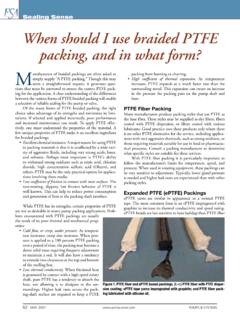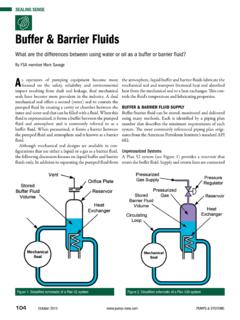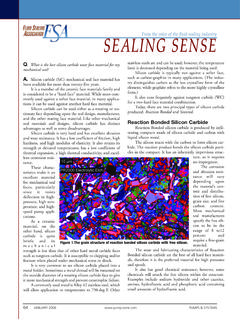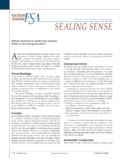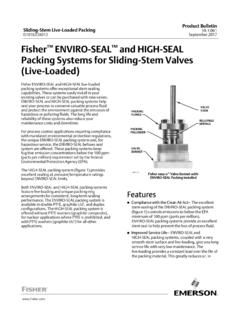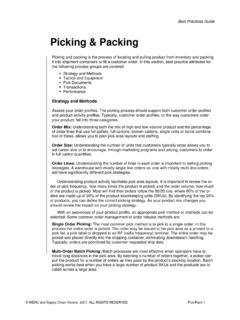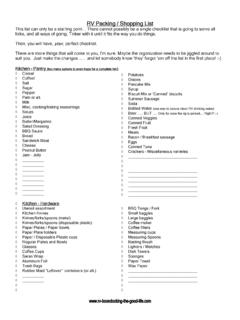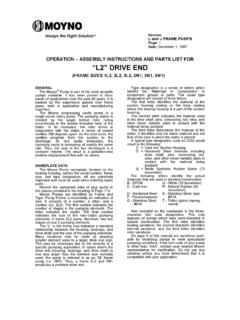Transcription of What are the current emission standards for valve …
1 70 M ay 2012 PuMPs & systeMsThe petroleum and chemical industries have been looking for meaningful stan-dards that will enable the qualification of valves that meet the increasingly stringent fugitive emission regulations, which have increased since the 1990s. The focus has been on the main source of the emissions valve stem packing . Several companies have evaluated current industry stan-dards and have crafted testing protocols specific to their application requirements. However, as the industry moves forward, end users and valve manufacturers should consider using a standard that best fits their StandardThe International standards Organization (ISO) developed the ISO-15848-1 and 2.
2 This two-part standard used information from a wide range of industry sources. The standard incorporates the testing of commodity valves as well as control valves. Industrial valves measurement, test and qualifica-tion procedures for testing fugitive emissions of industrial valves are described. Part 1 addresses a classification system and qualification procedures for type testing of valves while Part 2 covers pro-duction acceptance testing of valves. Part 1 Included in Part 1 is the testing of completely assembled valves using vacuum, bagging or sniffing (EPA Method 21), depending on which annex is used and the type and class of the valve .
3 The standard uses helium or methane as the test fluid and only permits one adjustment to the valve packing every performance cycle. Valves are typically tested vertically with horizon-tal as an option, with cycling rates based on the type of valve isolating or control. Stem packing leakage is catego-rized as A, B, C and D, for both helium and methane, with A the lowest. The amount of acceptable leakage is predetermined by the manufacturer or purchaser, and the difference between the leakage of helium and methane is not correlated.
4 The numbers of mechanical cycles for isolating valves are cat-egorized as CO1 500, CO2 1500 and CO3 2500. Mechanical classes for control valves are CC1 20,000, CC2 60,000 and CC3 100,000. Temperature classes range between -196 C and 400 C, with combinations of testing to establish the final ranges for service. Part 2 This acceptance test defines a method for evaluating valves at the manufacturer s site of valves already tested in Part 1. The procedure gives direction to the manufacturer and purchaser What are the current emission standards for valve packing ?
5 This month s sealing sense was prepared by Fsa member Rich the voice of the fluid sealing industrySealing SenSeFigure 1. ISO test devicePuMPs & systeMs M ay 2012 71as to the required percentage of valves to be tested per produc-tion lot. It also identifies helium as the only permitted fluids and provides a specification of 6 bar internal pressure. It is a room temperature test that requires that the valve be operated half open and then fully closed, leak checked and then cycled fully for five cycles with a final check for leakage at half open.
6 Whether the valve passes is based on the required leak limits for the categories in ISO 15848-1 but with sniffing as the method of taking the readings. Both parts are currently undergoing revision, and the final standard is expected to be published sometime later this year. The key changes are the addition of leakage rates for methane, the addition of category D, changes to the number of cycles required to qualify a commercial valve and a few others. API StandardsTwo American Petroleum Industry (API) standards must also be considered.
7 API 622 API developed Standard API 622 in response to the needs of the petroleum and chemical industries. The first edition of API 622 was designed to test fugitive emissions of valve packing , but it also allowed the valve company or packing manufacturer to test a completed valve . The test has undergone revision during 2011, and the second edition was published in November 2011. The new edi-tion eliminated the use of a standard valve and now requires the test facility to use a test device or rig that is designed to simulate a 4 inch, Class 300 rising or rising-rotating valve .
8 The test requires five thermal cycles from ambient temperature to 260 C (500 F) with 1,510 mechanical cycles, using methane as the test gas. Each set of ambient and thermal cycles is divided into 300 cycles per day and a final 10 cycles where the final leakage measurement is taken. Another key component of the stan-dard s improvement was the introduc-tion of an oxidation test of the flexible graphite packing material. This test specifies a limit of 15 per-cent oxidation during the 24-hour test and follows the procedure in Standard FSA-G-604-07, Method B.
9 Other parts of the second edition cover ambient and elevated temperature corrosion, along with packing material composition and property evaluations. The leakage limit of the test is 500 parts per million (ppm) with a limit of one adjustment. API 624 With the removal of assembled valves from the second edi-tion of API 622, API has decided to develop a new standard to cover rotating and rising-rotating stem valves. The new stan-dard is API 624: Type Testing of Rising Stem Valves Equipped with Flexible Graphite packing for Fugitive Emissions.
10 Currently under development, the standard will use EPA Method 21 as a basis for the evaluation of fugitive emissions, with the leakage limit set at 100 ppm methane. It requires that the tested valve packing be previously tested according to API 622 and be suit-able for use at service temperatures 29 C to 538 C ( 20 F to 1,000 F). The draft document currently requires that the valve be selected for testing by a test lab or end user. For valves not in stock, the manufacturer must certify that the test valve was not modified in any way to meet type test requirements and is a typical representation of the manufacturer s stock product.
